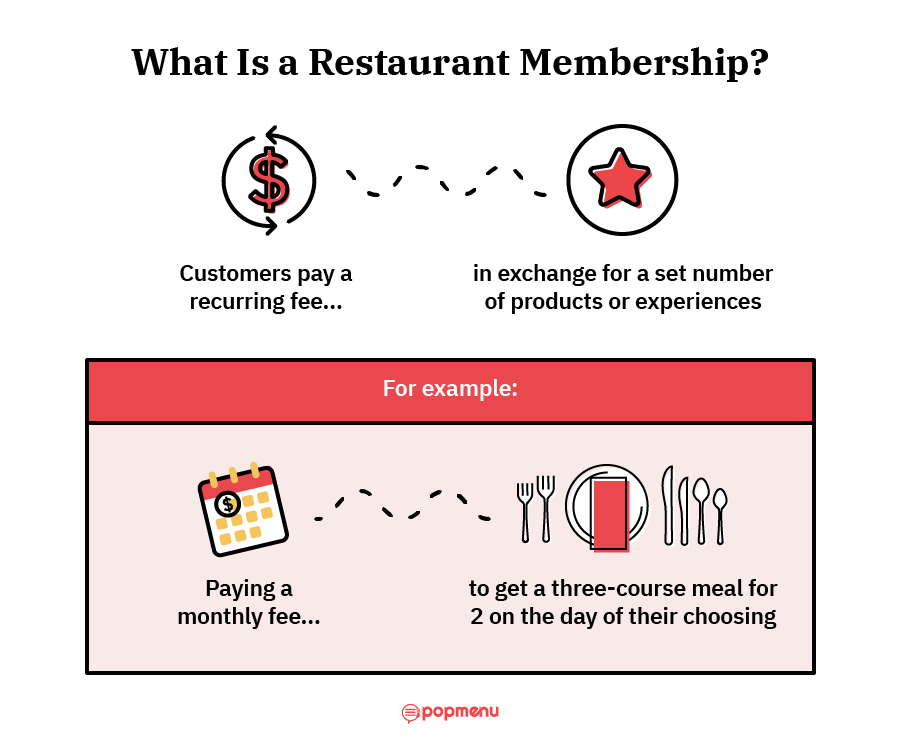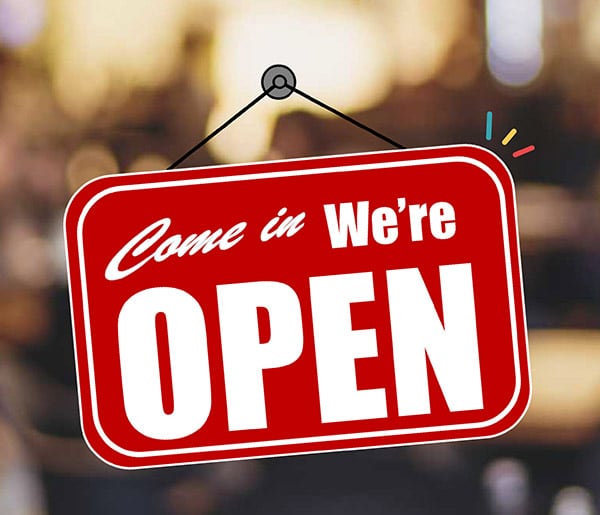
Is restaurant membership just a fad or here to stay?

Today's consumers subscribe to all kinds of things: Streaming services, subscriptions boxes, Amazon Prime. Why not restaurants?
The idea of a restaurant membership, or a subscription to a restaurant, is not new. In fact, it's something that restaurants all over the country have implemented, some with great success. But are subscription models the future of the restaurant industry, or are they just a pandemic-fueled fad?
Let's take a look at this trend, how it's benefitting restaurants, and some of the obstacles that stand in the way of it becoming more of a staple in the industry. If you're wondering if offering a membership program is the right move for your restaurant, read on to learn more.
What Is a Restaurant Membership and How Does It Work?
A restaurant membership (sometimes also called a restaurant subscription) allows guests to "sign up" for their favorite restaurants, paying a monthly, quarterly, or yearly fee in exchange for a certain set number of products or experiences.

There's a lot about restaurant memberships that can vary, depending on the restaurant itself. But here's an example: A beloved local restaurant begins offering its guests the opportunity to "subscribe," paying a set price each month, and receiving one three-course meal for two each month on a day of their choosing. The arrangement should be mutually beneficial—the guests get pre-paid meals, typically at a discount from regular menu prices, while the restaurant receives predictable, recurring revenue in the form of a stable monthly payment.
This kind of model is extremely popular with millennials and Gen Z. Think Amazon Prime, which charges a subscription price that offers perks and better convenience while shopping online. Or streaming services, which allow customers to ditch expensive cable packages and instead, pay small monthly fees for curated content. There's also been a recent rise in a more luxe version of this—take Peloton, for example, a luxury workout system that asks guests to pay a monthly subscription for access to fitness classes on top of high-priced, high-tech equipment.
There's a surprising amount of demand for restaurant memberships, according to a National Restaurant Association survey run last summer. 55 percent of all adults said they'd be interested in paying for a subscription to a restaurant in their neighborhood, with even higher interest among millennials. 1 in 20 survey respondents said they were interested in paying subscription fees to restaurants simply to help them stay afloat amid all the uncertainty and challenges of the last two years.
How do Memberships Benefit Restaurants?
For restaurants, a membership program can offer a variety of benefits.
Recurring Revenue
The first, and likely most appealing benefit is recurring revenue. A membership program gives restaurants a way to create a source of revenue that recurs on a regular basis—a far cry from typical restaurant revenue, which varies by season, day of the week, and even uncontrollable and unforeseeable factors like the weather.
In the business world, recurring revenue is seen as a sign of operational and financial stability. Historically, the restaurant industry hasn't naturally lent itself to creating recurring revenue streams. But subscription-model restaurant memberships have changed that, and opened new doors for all kinds of restaurants to achieve more financial stability.
Predictability
That brings us to the next big benefit of restaurant memberships: They create predictable revenue—that's part of the reason we've seen them explode in popularity in the last couple of years. Amid major industry challenges like the global pandemic and staffing shortages, memberships have created a way for some restaurants to create their own stability while the industry as a whole remains precariously unstable.
When the future is as uncertain as it seems to be now, there's a lot to be said for having any amount of predictable income. Memberships help restaurants cushion themselves against all the uncertainty they still face.
Loyalty
Studies show that in businesses across industries, it costs far more to find and attract new customers than it does to just retain the customers you already have. In fact, one study by Bain & Company showed that increasing customer retention by just 5 percent lead to an increase in profits of 25-95 percent for some businesses.

Restaurants are a little bit different than many of the businesses customer retention studies focus on, but retaining loyal customers (and keeping them happy) is something all restaurants should be striving for, nonetheless. Membership programs encourage guest loyalty and help ensure that guests make regular, repeat visits to your restaurant. A guest who likes your restaurant enough to subscribe to it is likely to bring friends and family there to eat and tell others about you, which acts as free marketing for your restaurant.
Trendiness
This last benefit for restaurants isn't as quantifiable as the others. But restaurant memberships are a pretty hot trend right now, and there is something to be said for being a restaurant that's on the cutting edge of what's hip, cool, and now.
Not only will embracing trends help your restaurant stay competitive (and stand out from the crowd); it also helps attract new guests who are always looking for the newest, coolest, trendiest thing. As Gen Z makes up more and more of the consumer market, restaurants will need to stay on-trend to attract these younger and more savvy diners.
What Types of Restaurants Offer Memberships?
When we say restaurant memberships are becoming more common, we mean it. You've probably already heard of a few, like Panera Bread's coffee subscription, or Taco Bell's taco membership.

But subscriptions and memberships aren't just for national chains. Many independent restaurants are also getting in on this trend.
Take Unsworth Restaurant, a farm-to-table eatery in Vancouver Island, for example. Unsworth calls itself a "community-supported restaurant." For a membership fee of $260 per year, members can make reservations for four different three-course dinners throughout the season, which runs from October to April.
Oddfellow Inn & Farm, a restaurant based in Helena, Montana, offers memberships to a 5-10 week meal kit subscription. Guests can upgrade their membership to include wine pairings with the farm-fresh meals they prepare at home with ingredients sent to them by Oddfellow.
Lawrenceville, New Jersey's Cafe Du Pain Bakery offers three-, six-, and 12-month bread and pastry club subscriptions through its website. Members pay for their subscription upfront, and then receive regular deliveries of artisanal pastries throughout their membership period.
Then there's New York City's Top Hops Beer Shop, which offers a membership service that allows guests to create a profile and have seasonal beer selections custom-picked to suit their tastes. Top Hops gives guests the opportunity to sign up online, and can ship beer selections to many parts of the U.S., meaning this subscription service not only creates new revenue, but expands their customer base significantly.
Will Restaurant Memberships Become an Industry Staple?
So are restaurant the latest restaurant trend that's here to say?
It's really anyone's guess. But there are still some barriers that leave offering memberships out of reach for many restaurants.
First, there's the technology. The restaurant guests who are most interested in memberships tend to be younger, more tech-savvy, and customer-service-oriented. That means they expect a seamless digital experience from something like a subscription, and many restaurants just don't have the technology to offer that. The restaurant industry, historically resistant to new technology, is beginning to come around to the digital age. But has that transformation happened quickly enough for the industry to be ready for memberships to become the norm? Unfortunately, no.
The other barrier, particularly for independent restaurants, is market size. Investing in technology to automate your membership program takes a lot of memberships—more than most small, local restaurants can realistically sell. But without that tech, it's up to restaurateurs to manage their membership programs manually, which takes time and extra work, adding to overhead that then cuts into the revenue generated by the program.
Is a Membership Program Right for Your Restaurant?
With both the benefits and the barriers in mind, is a membership program the right move for your restaurant? The answer may vary for each restaurant's individual circumstances. But to get a better idea of whether a membership program is right for you, ask yourself these questions about your restaurant:
Do you already have established, loyal regulars?
If the answer is yes, you have the foundation for a membership program. The guests who will be most likely to support and invest in subscriptions to restaurants are the ones who already love the restaurant and visit it frequently. That way, it's a win-win. The restaurant gets members, and the guests get a better deal on something they already love.
Of course, it's possible to build a membership program without an existing customer base. It will just take more work—and a lot more marketing. Expect to significantly increase your investment in your membership program (in both money and time) if you're starting from scratch.
Do you have a good "product" guests can subscribe to?
This question may seem deceptively easy to answer. Most restaurants would say yes, they can offer a meal for two, bottomless coffee, free appetizers, or some other promotion.
But before you launch your membership, you have to be sure of a few things. First, ensure that the "product" you're offering is appealing and universal enough that many guests will sign up to receive it regularly. Second, do the math—make sure you are not losing more than the membership is bringing in.
Restaurant profit margins are slim. Part of the appeal of a membership for guests is that they get a good deal from your restaurant by essentially buying in bulk. But it's crucial for restaurants to crunch the numbers carefully, and make sure they're still able to make money on their membership offerings.
Do you have the time (or technology) to manage subscriptions?
And finally, when considering starting a membership program at your restaurant, be realistic about what it will take to manage it. Do you have the technology to automate the program so guests can sign up and manage their memberships online? Do you have the funds to invest in that kind of technology? If not, do you have staff with enough time and the right skills to manually manage a program? How will you market it? How will you ensure you can deliver on the products promised to guests who join?
Starting a restaurant membership program takes time, planning, and sometimes, the right circumstances. But if you answered yes to all three of the questions above, your restaurant likely has a good chance at success.
Be Ready for the Next Big Restaurant Trend
Whether restaurant memberships soon fall out of style, or are here to stay, there's one restaurant trend that isn't going anywhere: the increasing industry reliance on technology. Tech tools are making restaurants more streamlined and efficient, helping them save on overhead and boost revenue; and by keeping up with technology, you ensure you're ready for whatever new trend comes next.
Make 2022 your restaurant's most digital-forward year yet. Explore Popmenu, the all-in-one digital toolkit for restaurants.





.jpeg)






